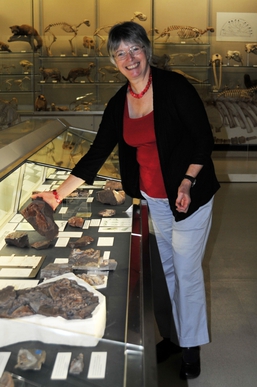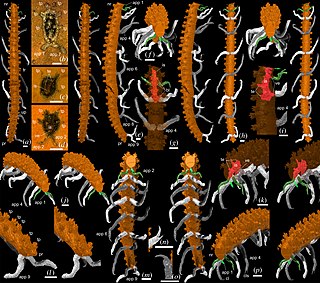
Paleontology, also spelled palaeontology or palæontology, is the scientific study of life that existed prior to, and sometimes including, the start of the Holocene epoch. It includes the study of fossils to classify organisms and study their interactions with each other and their environments. Paleontological observations have been documented as far back as the 5th century BC. The science became established in the 18th century as a result of Georges Cuvier's work on comparative anatomy, and developed rapidly in the 19th century. The term has been used since 1822 formed from Greek παλαιός, ὄν, and λόγος.

Conodonts are an extinct group of agnathan (jawless) vertebrates resembling eels, classified in the class Conodonta. For many years, they were known only from their tooth-like oral elements, which are usually found in isolation and are now called conodont elements. Knowledge about soft tissues remains limited. They existed in the world's oceans for over 300 million years, from the Cambrian to the beginning of the Jurassic. Conodont elements are widely used as index fossils, fossils used to define and identify geological periods.

Agnatha is an infraphylum of jawless fish in the phylum Chordata, subphylum Vertebrata, consisting of both living (cyclostomes) and extinct species. Among recent animals, cyclostomes are sister to all vertebrates with jaws, known as gnathostomes.

Charnia is an extinct genus of frond-like lifeforms belonging to the Ediacaran biota with segmented, leaf-like ridges branching alternately to the right and left from a zig-zag medial suture. The genus Charnia was named for Charnwood Forest in Leicestershire, England, where the first fossilised specimen was found. Charnia is significant because it was the first Precambrian fossil to be recognized as such.

Jennifer Alice Clack, was an English palaeontologist and evolutionary biologist. She specialised in the early evolution of tetrapods, specifically studying the "fish to tetrapod" transition: the origin, evolutionary development and radiation of early tetrapods and their relatives among the lobe-finned fishes. She is best known for her book Gaining Ground: the Origin and Early Evolution of Tetrapods, published in 2002 and written with the layperson in mind.

Richard Alan Fortey is a British palaeontologist, natural historian, writer and television presenter, who served as president of the Geological Society of London for its bicentennial year of 2007.
Derek Ernest Gilmor Briggs is an Irish palaeontologist and taphonomist based at Yale University. Briggs is one of three palaeontologists, along with Harry Blackmore Whittington and Simon Conway Morris, who were key in the reinterpretation of the fossils of the Burgess Shale. He is the Yale University G. Evelyn Hutchinson Professor of Geology and Geophysics, Curator of Invertebrate Paleontology at Yale's Peabody Museum of Natural History, and former Director of the Peabody Museum.

Michael James Benton is a British palaeontologist, and professor of vertebrate palaeontology in the School of Earth Sciences at the University of Bristol. His published work has mostly concentrated on the evolution of Triassic reptiles but he has also worked on extinction events and faunal changes in the fossil record.

Paleobiology is an interdisciplinary field that combines the methods and findings found in both the earth sciences and the life sciences. Paleobiology is not to be confused with geobiology, which focuses more on the interactions between the biosphere and the physical Earth.
Richard John Aldridge was a British palaeontologist and academic, who was Bennett Professor of Geology at the University of Leicester.
Mark Andrew Purnell is a British palaeontologist, Professor of Palaeobiology at the University of Leicester.
Ivan Sansom is a British palaeontologist, Senior Lecturer in Palaeobiology at the University of Birmingham. His research has focused primarily on the conodont palaeobiology and the early Palaeozoic radiation of vertebrates.
M. Paul Smith is a British palaeontologist, head of the Oxford University Museum of Natural History and professor in Kellogg College. Previously he was Professor of Palaeobiology at the University of Birmingham, head of the university's School of Geography, Earth and Environmental Sciences, and Director of its Lapworth Museum of Geology. He received his BSc from the University of Leicester and his PhD from the University of Nottingham.
Euan N.K. Clarkson FRSE is a British palaeontologist and writer.
Paraconodonts (Paraconodontida) are an extinct order of probable chordates, closely related or ancestral to euconodonts. The order contains the superfamily Furnishinacea, itself containing the families Westergaardodinidae and Furnishinidae.
Jerzy Dzik is a Polish paleontologist.

Palaeoworld is a peer-reviewed academic journal with a focus on palaeontology and stratigraphy research in and around China. It was founded in 1991 by the Nanjing Institute of Geology and Palaeontology at the Chinese Academy of Sciences (NIGPAS). The journal has been published quarterly since 2006; prior to 2006, it did not adhere to a fixed publication schedule.

Sam Giles is a palaeobiologist at the University of Birmingham. Her research combines modern imaging with fossils to understand the evolution of life, in particular that of early fish, and in 2015 "rewrote" the vertebrate family tree. She was a 2017 L'Oréal-UNESCO Rising Star and won the 2019 Geological Society of London Lyell Fund.
Anjali Goswami is a Resesarch Leader and Dean of the Graduate Centre at the Natural History Museum. She is an Honorary Professor of Paleobiology at University College London (UCL) in the Department of Genetics, Evolution, and Environment. She was elected President of the Linnean Society of London, in 2022 and is the first person of colour elected to this role since its founding in 1788. Goswami's expertise is in vertebrate evolution and development, particularly using high-resolution 3D images of specimens to quantify and reconstruct the evolution of biodiversity and understand how development, ecology and large-scale environmental effects have shaped animal evolution through deep time.

Thanahita is a genus of extinct lobopodian and known from the middle Silurian Herefordshire Lagerstätte at the England–Wales border in UK. It is monotypic and contains one species, Thanahita distos. Discovered in 2018, it is estimated to have lived around 430 million years ago and is the only known extinct lobopodian in Europe, and the first Silurian lobopodian known worldwide.










